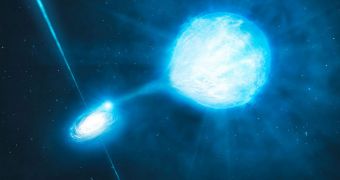For many years, astronomers have observed the fireballs left behind by supernova explosions, and they only saw symmetric remnants. But now the case is getting stronger that a particular type of supernova is capable of creating asymmetrical nebulae after the original explosion subdues.
There are several possible ways a supernova event can be classified. There are for example those called thermonuclear supernovae, which occur when a white dwarf interacts with another star, located nearby.
On the other hand, core-collapse (gravitational) supernovae only occur when massive stars, tens to hundreds of times the mass of the Sun, reach the end of their burning cycle, and exhaust their hydrogen fuel supplies.
When this happens, the force that kept them stable by opposing gravity disappears. As such, they implode, and then blow up in apocalyptic explosions that have certain grandeur to them.
Among gravitational supernovae, Type IIn are the rarest. Only three instances of such explosions have ever been discovered and analyzed by astronomers thus far. In all of them, the resulting fireball was asymmetric, experts say.
In the latest research to look at these rare objects, the Calar Alto telescopes were used to analyze the supernova 2010jl, which made itself visible to observers in November 2010.
The study was conducted using an investigations technique called spectropolarimetry, by an international team of experts led by astronomer F. Patat, of the European Southern Observatory (ESO).
SN 2010jl lies some 160 million light-years away, in the constellation Leo. It was located in the UGC 5189A galaxy, which is itself deformed due to massive tidal interactions with its galactic neighbors.
Astronomers with the team believe last year's Type IIn explosion was caused by a Wolf-Rayet X-ray binary, a system that contained a massive, Wolf Rayet-type star. This object is estimated to have been 30 times heavier than the Sun.
This means that it only burned for several millions of years before exhausting its hydrogen fuel. While it existed, it produced a large envelope of radiation and matter around itself. This layer was formed by the particles the star emitted through stellar winds.
When the core blew up, one of two things happened – either the core exploded asymmetrically, or the envelope was not spherical, but had another shape. The team has yet to decide what the most feasible explanation is.
Both these scenarios explain the peculiar shape of the ensuing fireball, Daily Galaxy reports.

 14 DAY TRIAL //
14 DAY TRIAL //